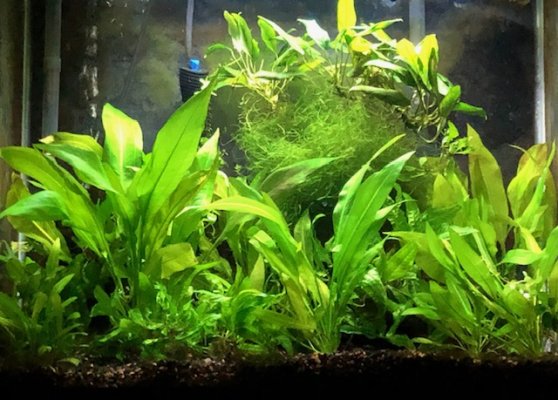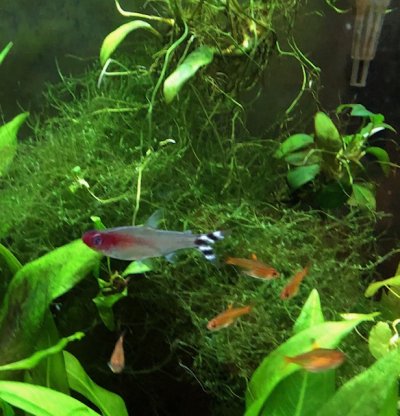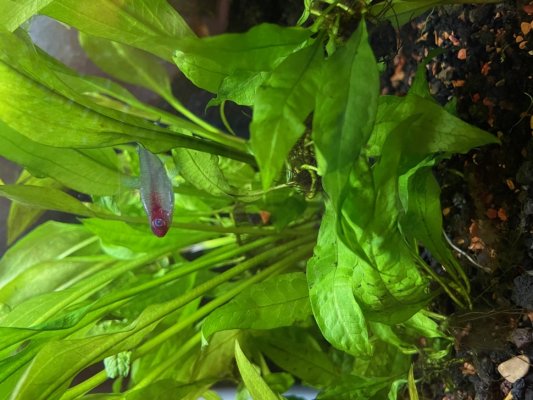Stocking at time of catastrophe: 7 ember tetra, about 12 amano shrimp, 10 rummynose tetra.
Stocking prior to catastrophe: 5 ember tetra, about 12 amano shrimp, 3 rummynose tetra.
I purchased 7 rummynose tetra and 2 ember tetras to add to existing schools. (I realize that’s a lot of bioload addition at once, but I was prepared for extra water changes and have been looking for rummynose tetra for about 3 years to replenish my school and ever since supply chain issues, they’d been impossible to find. I drove 2 hours to a highly recommended fish store to buy them) I dosed a small dose of PimaFix and MelaFix as a preventative, which I’ve done with new fish for years. New rummies had colored up nicely and all seemed well after a couple of days. Soon, 2 of my new fish looked a little lethargic and pale, but I chalked it up to transition. The next morning, I walked in to find every fish dead. I tested water parameters frantically amidst the tears and removing them. I was sure I was about to encounter some sort of water parameter problem, but I did not and also found through the major cleaning not a single dead shrimp and every single one of them fine. There was not a single sign of illness on any of the fish after first inspection and I even fridged them and further inspected later after I had myself more emotionally under control.
Not only did the new ones die, but also my 5 existing ember tetra (had them 2 years) and my 3 existing rummynose. (2 of them I’d had 7 years and 1 of them 9 years. Other than cataracts, even my elderly rummies were in good health. I realize that’s past the normal listed lifespan for captivity, but I’ve always been good with tetra) I’ve been keeping fish for over 20 years and have never seen anything like these deaths.
I called the fish store to ask if they’d had any problems with the rummynose or embers they had in stock. They said another client had called them about a die off after purchasing. The lady told me they “should be free of disease because we dosed them up with doxycycline before selling them” Has anyone heard of fish stores doing that? She thinks since my inverts are fine it was some sort of bacterial disease that only affects fish. Has anyone heard of anything like this happening?
I feel absolutely crushed and after 20 years of this hobby bringing me so much joy, I’m thinking about throwing in the towel as I can’t even write this without being a blubbering mess. Of course I’m sad to lose the new fish, but I’m devastated over my rummies that I’d had for 7 and 9 years. (The only fish I’ve lost in the past few years has been rummies from that school dying of old age over the course of several years… it was once a school of 12 rummies)
I feel like I have to get to the bottom of this. Does anyone see anything in this that could have caused such rapid death with no outward signs?
Tank: 37gallon freshwater, heavily planted, PH 6.5-6.6, Ammonia 0, Nitrite 0, Nitrate 5ppm, Temperature 79, filtration 2 Aquaclear HOB with sponges, 2 airstones on pumps. Prime as my conditioner, Flourish line of ferts including comprehensive, excel, trace, iron, and potassium. Weekly 20% water change schedule including gravel vac each week, the 4 filter sponges are squeezed and swished in bucket of tank water with an alternating schedule so I'm only swishing 2 at a time to maintain biofilter, 4 sheets water polishing floss changed out weekly (2 per HOB with the sponges) setup well cycled and established for 10 years. Food is a rotation of freeze dried brine shrimp, micro pellets, and omnivore flake.
I’m sorry for the long post, but I wanted to get all relevant info in. (I performed a 50% water change after the catastrophe and several smaller ones over the past week out of fear for my shrimp. All shrimp are doing well and plants unaffected)
Any suggestions or help would be wildly appreciated.
(Yes, I should have QT and I don't know that I'll ever forgive myself for that seeing as I lost my old rummies, but I can't change that... what I need now is to understand... and make an informed decision if I even want fish again as I'm still reeling from finding all my fish dead a week ago... I don't know if I'm going to be able to shake that.)
Thank you to anyone who made it through my long post! I attached a tank pic for an idea of setup we're talking about.
Stocking prior to catastrophe: 5 ember tetra, about 12 amano shrimp, 3 rummynose tetra.
I purchased 7 rummynose tetra and 2 ember tetras to add to existing schools. (I realize that’s a lot of bioload addition at once, but I was prepared for extra water changes and have been looking for rummynose tetra for about 3 years to replenish my school and ever since supply chain issues, they’d been impossible to find. I drove 2 hours to a highly recommended fish store to buy them) I dosed a small dose of PimaFix and MelaFix as a preventative, which I’ve done with new fish for years. New rummies had colored up nicely and all seemed well after a couple of days. Soon, 2 of my new fish looked a little lethargic and pale, but I chalked it up to transition. The next morning, I walked in to find every fish dead. I tested water parameters frantically amidst the tears and removing them. I was sure I was about to encounter some sort of water parameter problem, but I did not and also found through the major cleaning not a single dead shrimp and every single one of them fine. There was not a single sign of illness on any of the fish after first inspection and I even fridged them and further inspected later after I had myself more emotionally under control.
Not only did the new ones die, but also my 5 existing ember tetra (had them 2 years) and my 3 existing rummynose. (2 of them I’d had 7 years and 1 of them 9 years. Other than cataracts, even my elderly rummies were in good health. I realize that’s past the normal listed lifespan for captivity, but I’ve always been good with tetra) I’ve been keeping fish for over 20 years and have never seen anything like these deaths.
I called the fish store to ask if they’d had any problems with the rummynose or embers they had in stock. They said another client had called them about a die off after purchasing. The lady told me they “should be free of disease because we dosed them up with doxycycline before selling them” Has anyone heard of fish stores doing that? She thinks since my inverts are fine it was some sort of bacterial disease that only affects fish. Has anyone heard of anything like this happening?
I feel absolutely crushed and after 20 years of this hobby bringing me so much joy, I’m thinking about throwing in the towel as I can’t even write this without being a blubbering mess. Of course I’m sad to lose the new fish, but I’m devastated over my rummies that I’d had for 7 and 9 years. (The only fish I’ve lost in the past few years has been rummies from that school dying of old age over the course of several years… it was once a school of 12 rummies)
I feel like I have to get to the bottom of this. Does anyone see anything in this that could have caused such rapid death with no outward signs?
Tank: 37gallon freshwater, heavily planted, PH 6.5-6.6, Ammonia 0, Nitrite 0, Nitrate 5ppm, Temperature 79, filtration 2 Aquaclear HOB with sponges, 2 airstones on pumps. Prime as my conditioner, Flourish line of ferts including comprehensive, excel, trace, iron, and potassium. Weekly 20% water change schedule including gravel vac each week, the 4 filter sponges are squeezed and swished in bucket of tank water with an alternating schedule so I'm only swishing 2 at a time to maintain biofilter, 4 sheets water polishing floss changed out weekly (2 per HOB with the sponges) setup well cycled and established for 10 years. Food is a rotation of freeze dried brine shrimp, micro pellets, and omnivore flake.
I’m sorry for the long post, but I wanted to get all relevant info in. (I performed a 50% water change after the catastrophe and several smaller ones over the past week out of fear for my shrimp. All shrimp are doing well and plants unaffected)
Any suggestions or help would be wildly appreciated.
(Yes, I should have QT and I don't know that I'll ever forgive myself for that seeing as I lost my old rummies, but I can't change that... what I need now is to understand... and make an informed decision if I even want fish again as I'm still reeling from finding all my fish dead a week ago... I don't know if I'm going to be able to shake that.)
Thank you to anyone who made it through my long post! I attached a tank pic for an idea of setup we're talking about.
Attachments
Last edited:



